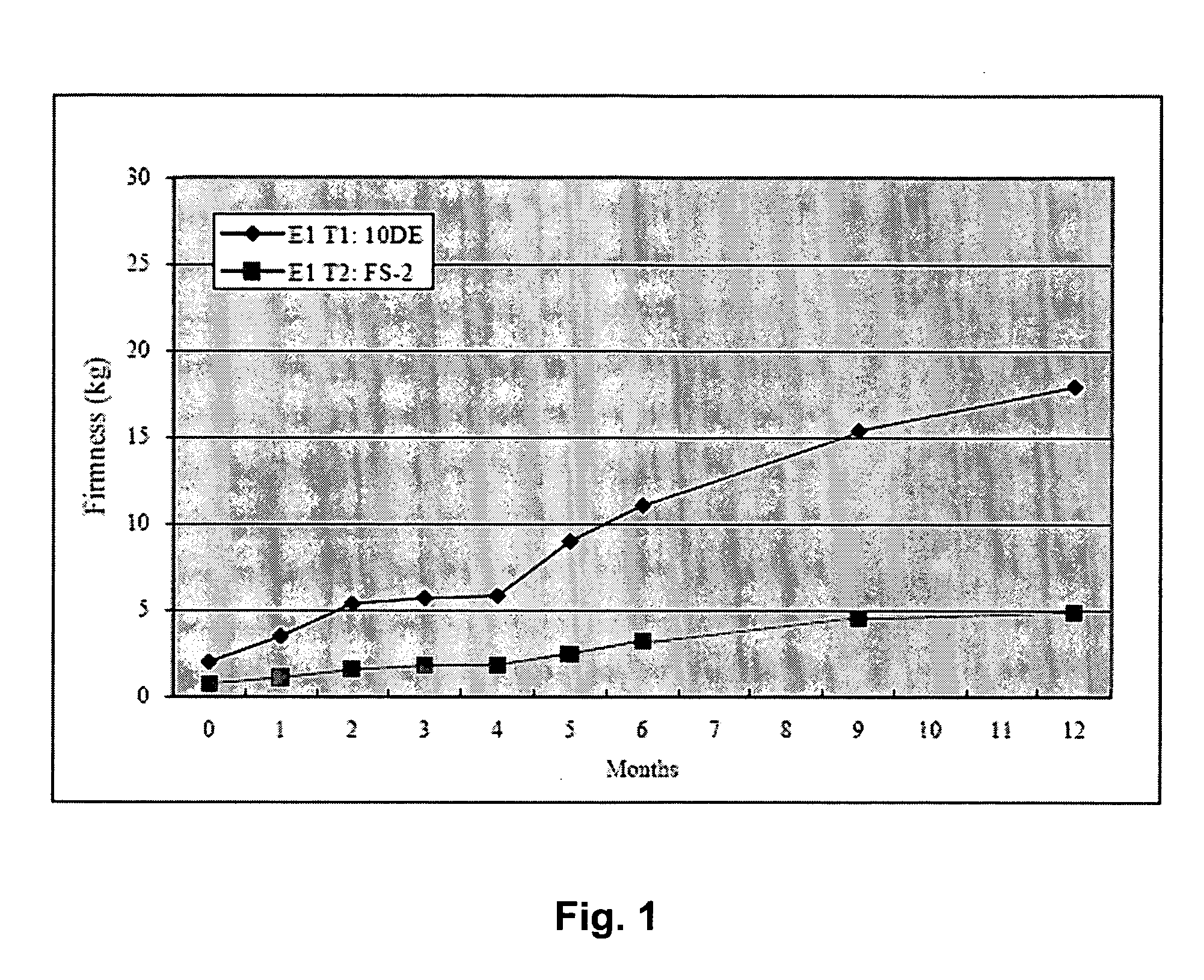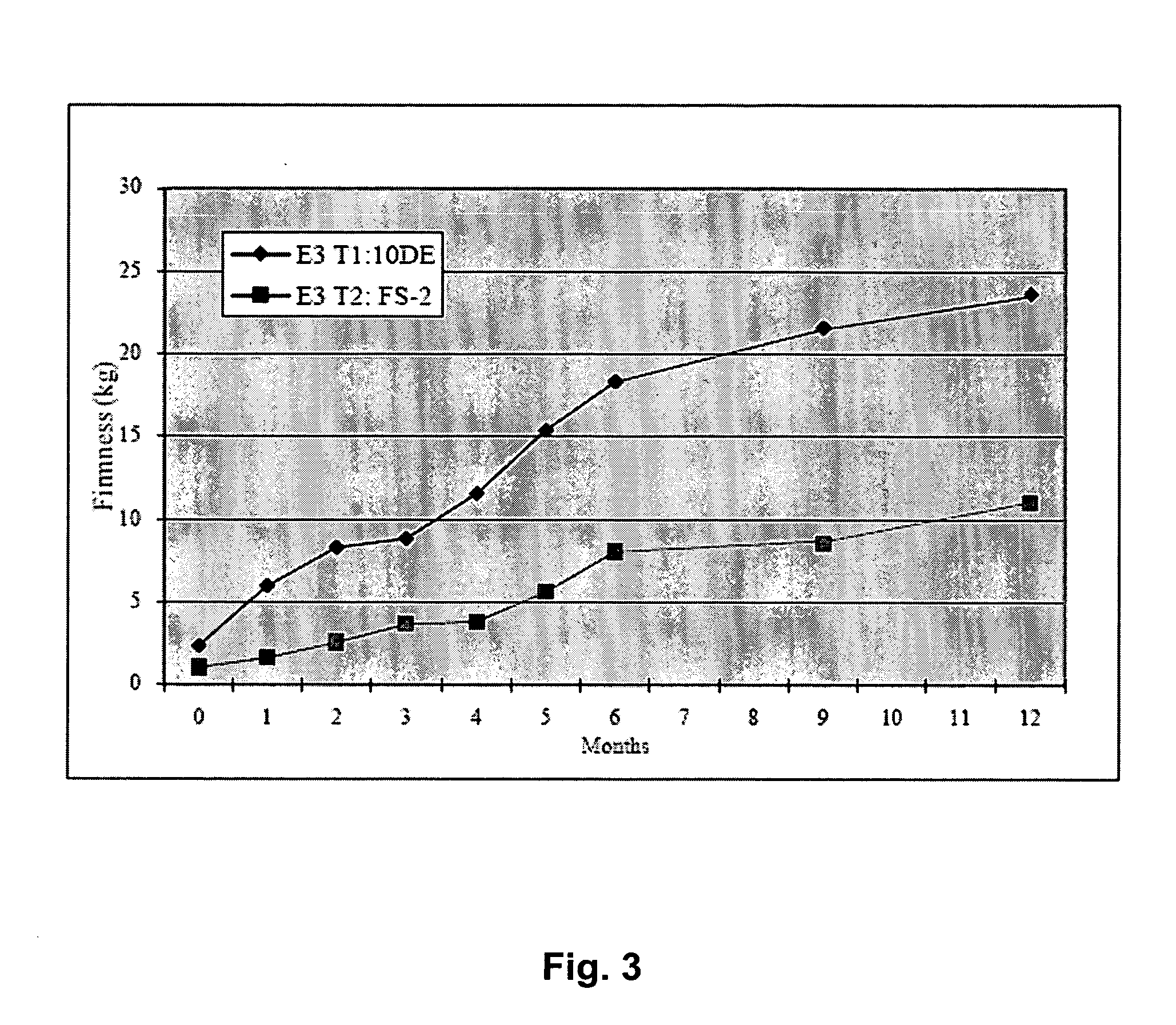Food bar with reduced hardness
a technology of food bars and hardness, applied in the field of food bars with reduced hardness, can solve the problems of minimal effectiveness in preventing moisture transfer to protein ingredients, and the hardness of bars containing protein ingredients over their shelf life, and achieve the effect of increasing the initial softness of the bar, without reducing the shelf life of the bar, and increasing the initial amount of certain functional ingredients
- Summary
- Abstract
- Description
- Claims
- Application Information
AI Technical Summary
Benefits of technology
Problems solved by technology
Method used
Image
Examples
example 1
Food Bar with Increased Shelf Life
[0057] The addition of a softener such as, but not limited to, Fibersol-2 to food bar formulations have the ability to cause softening of the bar texture, both initially after production and also during shelf-life. A texture study was therefore conducted by incorporating Fibersol-2 into a bar model formulation. Profam 825 is an isolated soy protein product (by definition 90% protein on dry basis).
TABLE AControl Bar Formulation.% of totalIngredient36.49Soy Isolate (Pro-Fam ™ 825)31.26HFCS 4231.2642 / 43 DE corn syrup0.27Lecithin Beakin LV30.72Sunflower Oil (Nu-Sun)100.00%Total
[0058]
TABLE BSoluble Fiber Bar Formulation.% of totalIngredient35.59Soy Isolate (Pro-Fam ™ 825)5.77Fibersol-228.85HFCS 4228.8542 / 43 DE corn syrup0.27Lecithin Beakin LV30.67Sunflower Oil (Nu-Sun)100.00%Total
[0059] Bar Production Method:
[0060] Pre-heat corn syrup in microwave on high for 30 seconds (to about 120° F.).
[0061] Place HFCS and corn syrup in bowl of Kitchen-Aid Mixer...
example 2
High Protein Food Bar
[0081] To study the differences between extending shelf life by addition of soluble fiber versus the addition of maltodextrin, comparisons of 10DE maltodextrin and Fibersol-2 in a bar model system were conducted. 10DE maltodextrin was replaced 1:1 by Fibersol-2 in two different protein ingredient bar model systems. The first model system was a combination of dairy proteins (whey protein and caseinate). The second model system was the combination of soy and the two dairy proteins. Total protein was 36% in the two formulations. 10 DE maltodextrin or Fibersol-2 was used at 9%. The second model system was repeated for milk proteins from two different sources (FarBest Brands, Louisville, Ky., USA, and NZMP, Auckland, New Zealand).
[0082] In measuring texture, two replicates per treatment were measured, and strain was set at 40%.
TABLE CDairy Protein Bar Formulation.% of totalIngredient9.0310 DE maltodextrin or Fibersol-218.05Whey protein isolate9.03Calcium caseinat...
example 3
Formulations Containing Highly Branched Carbohydrates
[0094] Fibersol is highly branched. Another experiment was done to evaluate other highly branched carbohydrates in comparison to Fibersol, including fructo-oligosaccharides (FOS), inulin, 10 DE maltodextrin (“MD”), polydextrose, and Lodex 10 (a highly-branched maltodextrin; Cerestar USA, Hammond, Ind., USA). The control formulation for a 500 gm batch of soy dairy bar formulation is provided in Table F below. To this formulation were added the carbohydrates listed in Table G (below, under “Carbohydrate Bar Types”). The listed ingredients were gradually substituted for Fibersol in the formulation at a rate of 9.03% total.
TABLE FBasic Bar Formulation.Bar% of totalTypeIngredientbar wgtgramsADM ProFam 82514.4072.00Farbest WPI 90010.8254.12Farbest 270 Ca caseinate5.4127.06Farbest WPC 755.4127.06ADM 62 DE Corn syrup36.68183.42ADM HFCS 4216.6183.07ADM Beakin LV30.934.67ADM Nu-Sun Oil0.703.48
[0095]
TABLE GCarbohydrate Bar Types.Bar% of t...
PUM
 Login to View More
Login to View More Abstract
Description
Claims
Application Information
 Login to View More
Login to View More - R&D
- Intellectual Property
- Life Sciences
- Materials
- Tech Scout
- Unparalleled Data Quality
- Higher Quality Content
- 60% Fewer Hallucinations
Browse by: Latest US Patents, China's latest patents, Technical Efficacy Thesaurus, Application Domain, Technology Topic, Popular Technical Reports.
© 2025 PatSnap. All rights reserved.Legal|Privacy policy|Modern Slavery Act Transparency Statement|Sitemap|About US| Contact US: help@patsnap.com



